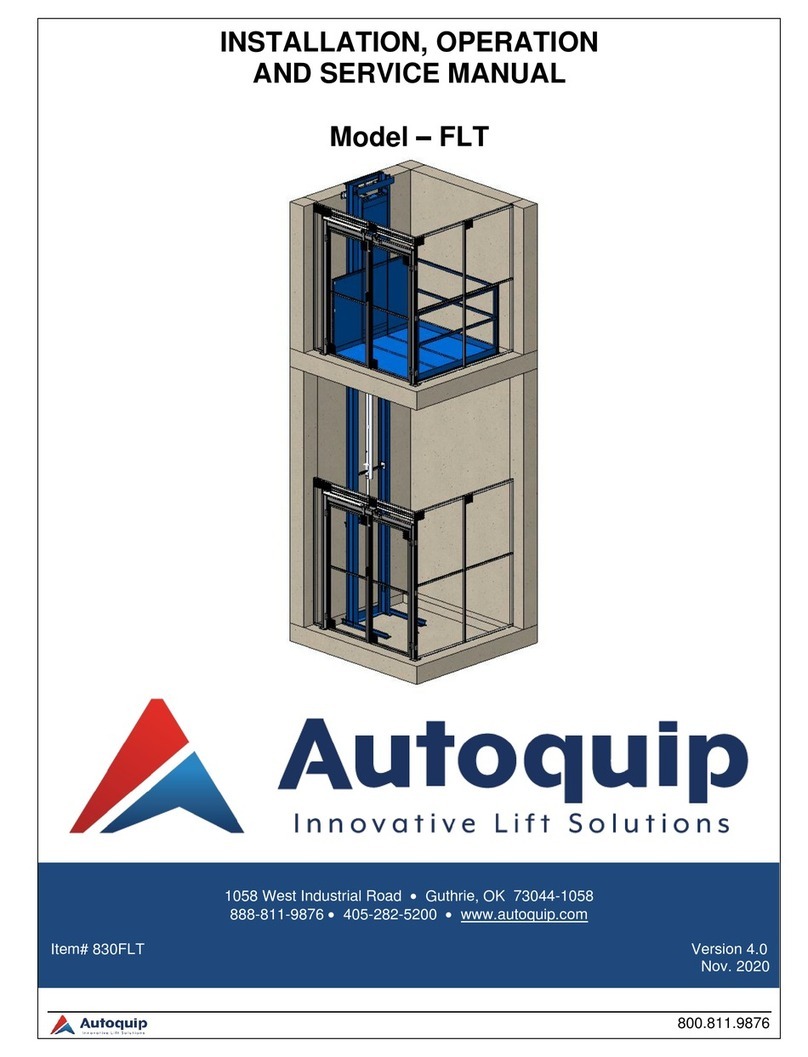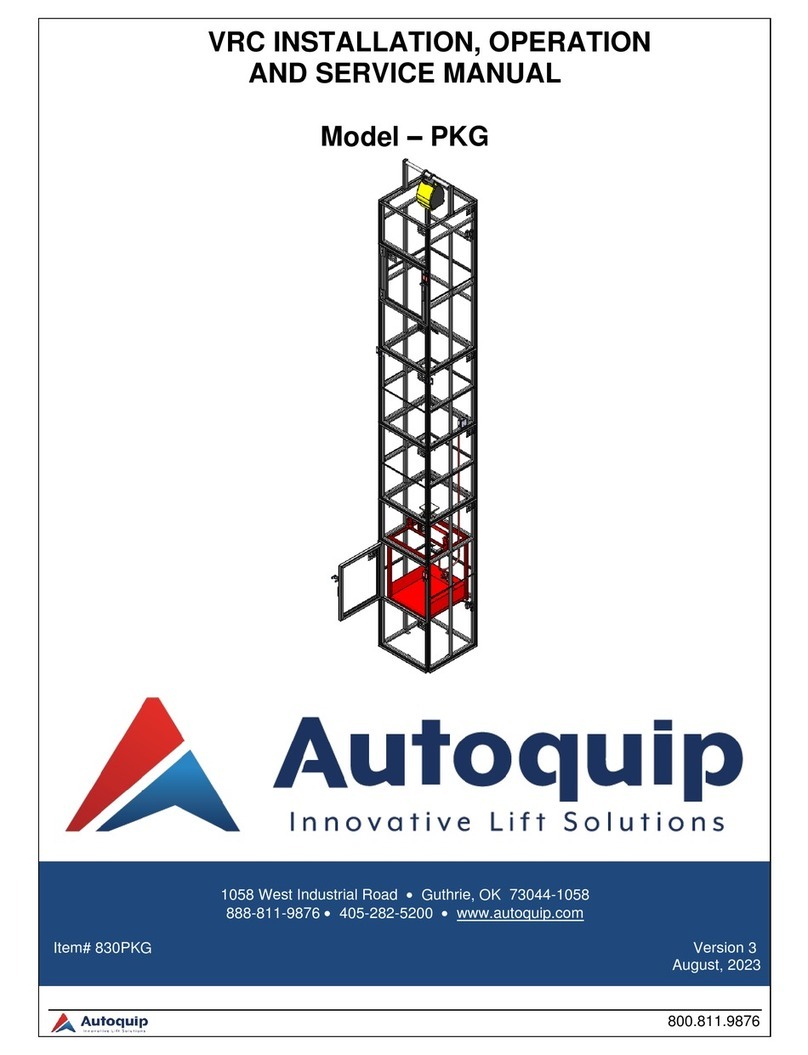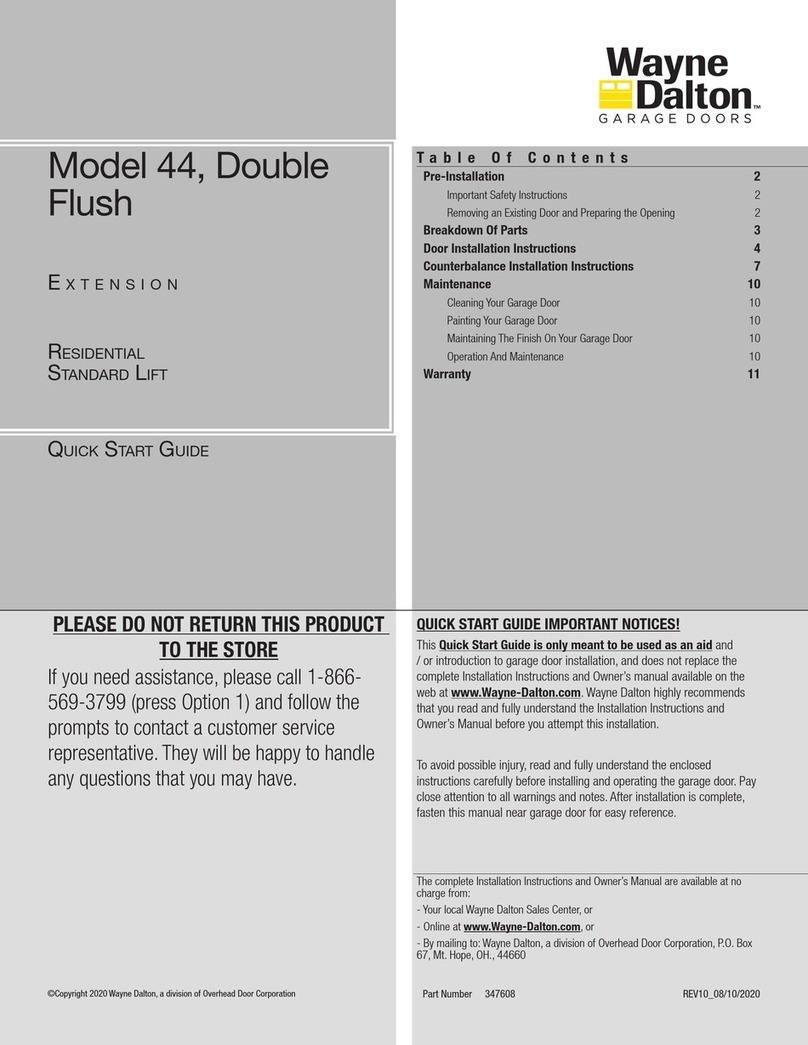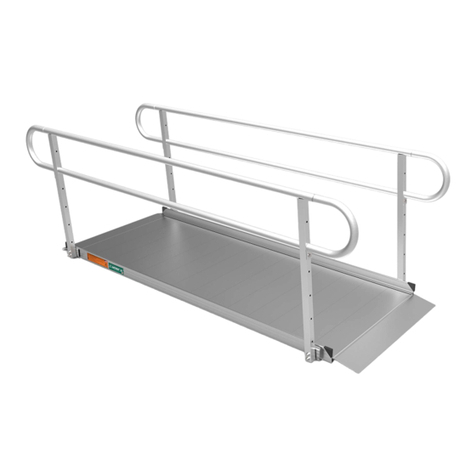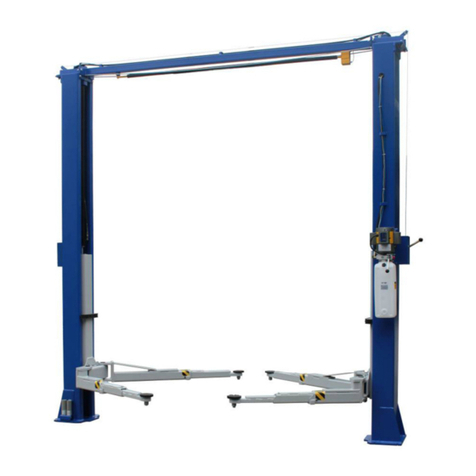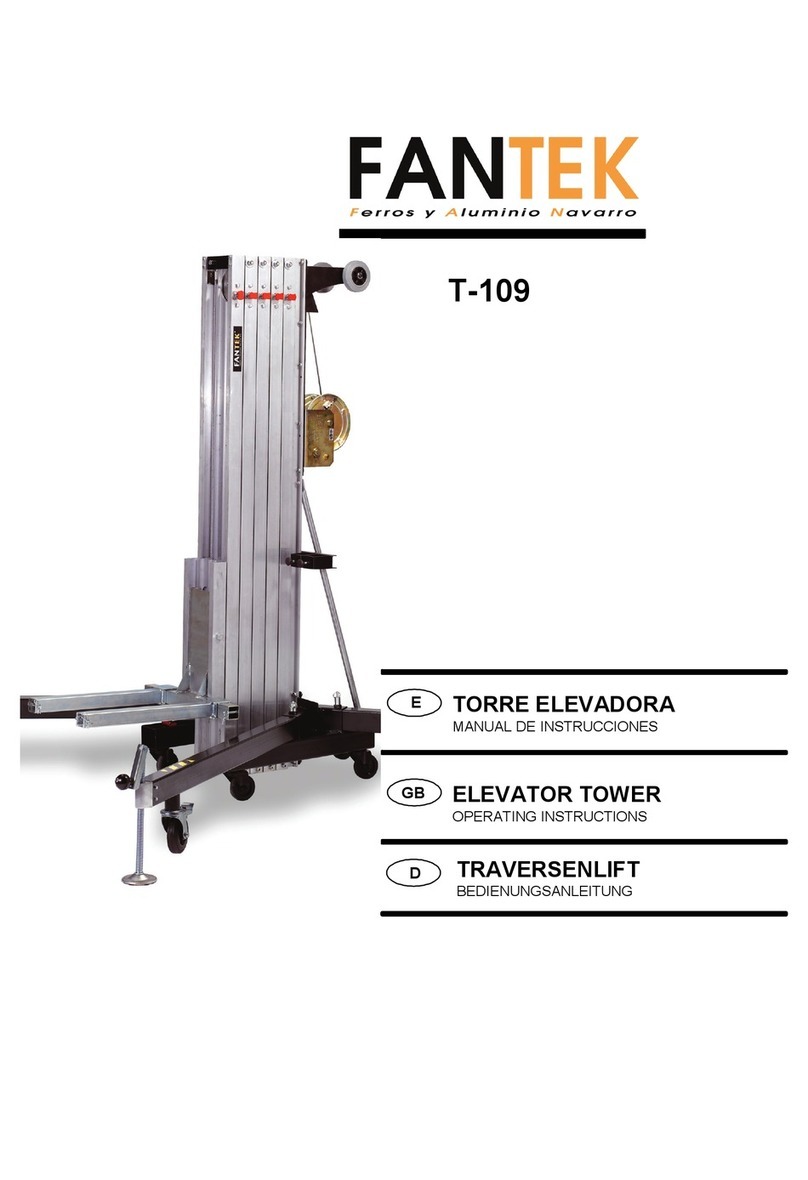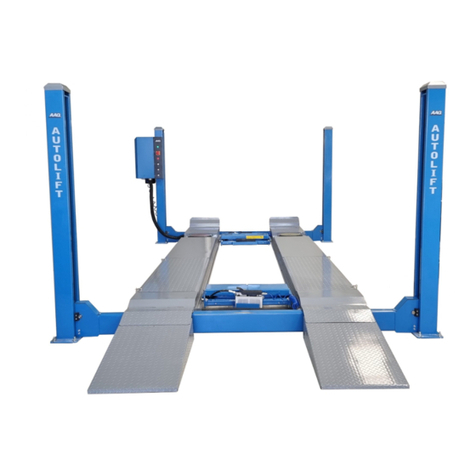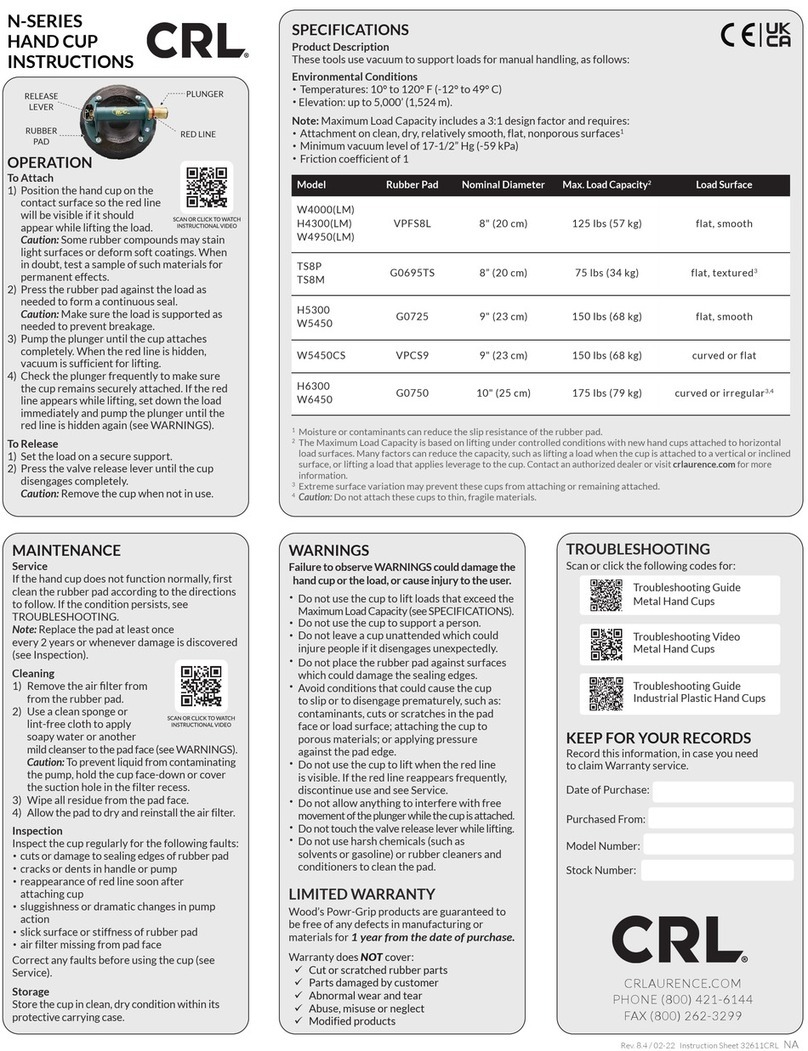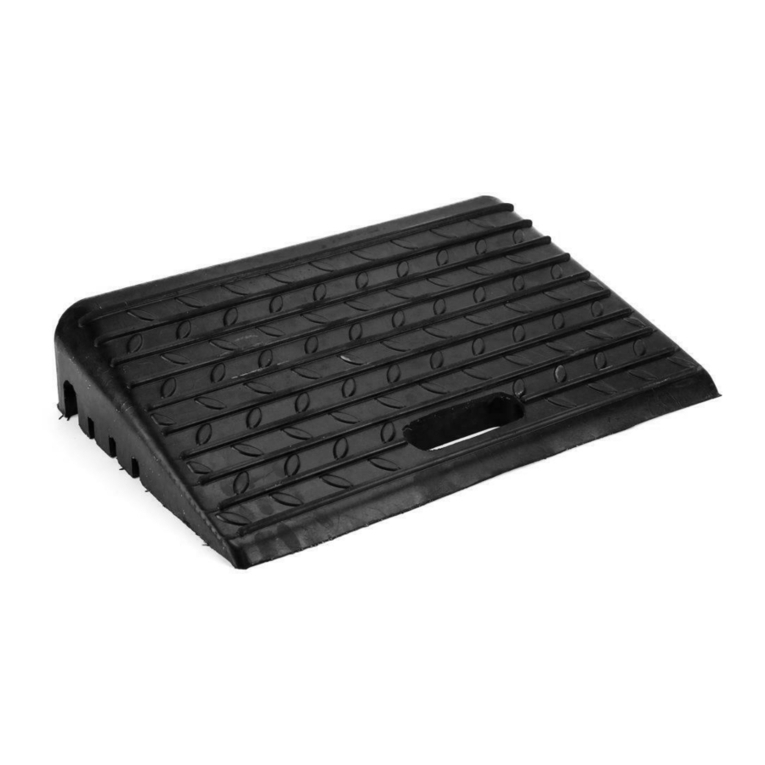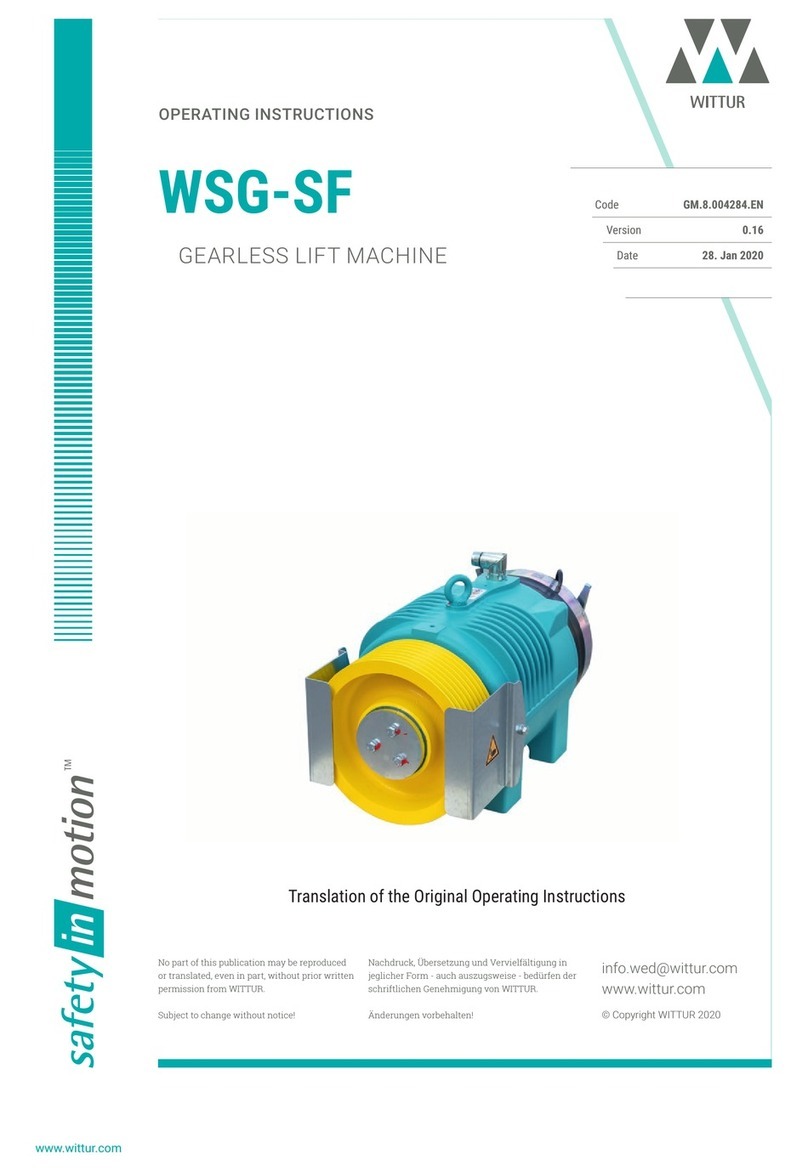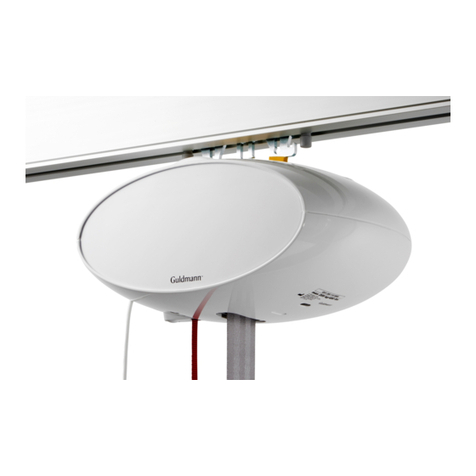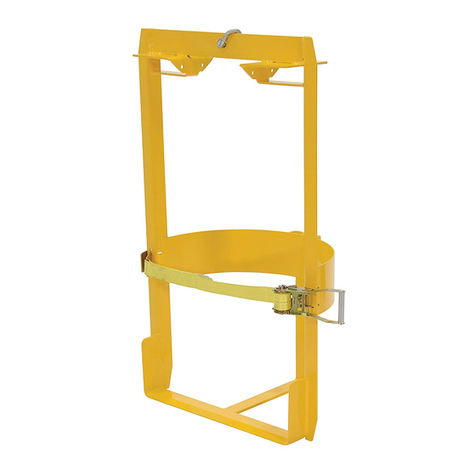Autoquip FLH Setup guide

FREIGHTLIFT
Model FLH
P.O. Box 1058 1058 West Industrial Avenue Guthrie, OK 73044-1058 888-811-9876
405-282-5200 FAX: 405-282-3302 www.autoquip.com
830FLH Version 3
June 2012
INSTALLATION, OPERATION
AND SERVICE MANUAL

2
Introduction & Company Contact Information 3
Inspection & Identification of Parts 4
Responsibility of Owners/Users 5
Safety Signal Words 6
Safety Practices 7
Safety Features 14
Label Identification 18
Specifications 21
Blocking Instructions 22
Installer Guidelines & Responsibilities 24
Installation Instructions 29
Operating Instructions 68
Routine Maintenance 73
General Maintenance 76
Replacement Parts List 93
Troubleshooting Analysis 94
GlossaryofTerms 98
Appendix – Inspection Checklist 100
Warranty 103
Please record the following information and refer to it when calling your dealer or
Autoquip.
Model Number:________________Serial Number: ___________________
Installation Date _____/_____/_____
TABLE OF CONTENTS

3
CODE REQUIREMENTS
VRCs are NOT elevators. This lift is designed for the transfer of material only from one
level to another. Absolutely NO RIDERS! VRCs have their own national safety code
(ANSI/ASME B20.1) and are specifically exempt from the National Elevator Code.
Some states require special components and have specific guidelines regarding how
the equipment must be installed, inspected, and tested. The owner is ultimately
responsible for understanding these requirements for the specific job location, and
Autoquip will incorporate any special requirements into the order as requested and
approved by the customer.
Call Autoquip Corporation at (405) 282-5200 or 1-888-811-9876 with any questions
you may have concerning VRC code requirements.
IMPORTANT
Autoquip Corporation has designed and manufactured the FREIGHTLIFT to safely and
efficiently move materials between multiple floors or levels. It has been built to provide
many years of dependable service.
INSTALLERS - Proper installation of this equipment is vital to both the efficiency of the
unit and the ultimate satisfaction of the end user. It is vital for the installers to read
and understand this manual! These instructions have been prepared and organized
to assist the installers and it is important for these individuals to carefully follow the
steps in the order they are presented!
OPERATORS - Please read and understand this manual prior to operation of this
Freightlift. Failure to do so could lead to property damage and/or serious personal
injury.
Situations may arise which are not covered in this manual. If you have questions,
please call Autoquip Customer Service at (405) 282-5200 or 1-888-811-9876.
NOTE: Unless otherwise stated, mechanical installation does not include
unloading, permits, seismic calculations, or extensive acceptance testing. The
requirements of each contract should be carefully reviewed for possible conflicts
of interpretation.
PLANNED MAINTENANCE PROGRAM
A local Autoquip representative provides a Planned Maintenance Program (PMP) for
this equipment using qualified and experienced personnel. Call a local representative
or Autoquip Corporation at 1-888-811-9876 or 405-282-5200 for more information.
INTRODUCTION

4
Your FREIGHTLIFT arrives packaged as follows: The two (2) masts with
cylinders/sheaves/cable, and platform come banded together, you also receive parts
crates/boxes which normally contain the smaller of the following items:
The following items are typically shipped within each FREIGHTLIFT order:
A. Two Carriage Upright Assemblies
B. Four Carriage Side Guards (Handrails)
C. Two Upper & Two Lower Guide Wheel Assemblies
D. Two Tension Roller Assemblies
E. One Overhead Channel
F. One Mast Cross Channel
G. Two (minimum) Horizontal Brace Channels
(and miscellaneous lengths of channel for bracing)
H. One Hydraulic Power Unit, One Control Panel, Two (min.) P/B
I. Three 20' lengths of Pressure Hose and Fittings
J. One 50' length of Breather Tube and Fittings
(and miscellaneous Hardware, Manuals, and Signs)
NOTE: The “Bill of Lading” will state the number of pieces shipped. TWO ITEMS
MAY BE BANDED TOGETHER AND COUNT AS ONE PIECE.
Upon receipt of the shipment, check for exposed damage or shortages and make note
of it on the trucking company Bill of Lading or the Shipping Papers. Reports of
concealed damage to items contained in crates must be reported within 48 hours. DO
NOT destroy the crating while opening it to inspect the contents. If damage is
suspected or found, report it directly to the carrier. DO NOT contact Autoquip
Corporation!! All shipments are FOB from the Autoquip plant. Any claims for damage
must be filed with the carrier. Any parts shipped from Autoquip that are intended
to replace damaged or lost items will be invoiced to the ordering party.
Assuming no damage has occurred to the crate, check the components against the
packing list. This will provide assurance that every item shipped has been received.
Everything needed for the installation should be available. If not, report any shortages to
Autoquip Corporation within 10 days. (Autoquip is not responsible for parts lost, stolen
or damaged during transportation, storage, installation, or during any other
circumstances or conditions that may be beyond Autoquip’s control.)
INSPECTION & IDENTIFICATION

5
CODE COMPLIANCE
Ultimate responsibility for gaining state and local code approval is the responsibility of
the buyer of the VRC. Please acquaint yourself with the permitting and/or licensing
expenses and requirements of the local regulatory agencies in the installation area.
.
INSPECTION & MAINTENANCE
The lift shall be inspected & maintained in proper working order in accordance with this
manual and with other applicable safe operating practices.
REMOVAL FROM SERVICE
Any lift in service which is not in safe operating condition such as, but not limited to,
excessive leakage, missing rollers, pins, or fasteners, any bent or cracked structural
members, cut or frayed electric or hydraulic lines, damaged or malfunctioning controls
or safety devices, etc. shall be removed from service until repaired to original
manufacturer’s standards.
REPAIRS
All repairs shall be made by qualified personnel in conformance with Autoquip’s
instructions.
OPERATORS
Only trained personnel and authorized personnel shall be permitted to operate the lift.
BEFORE OPERATION
Before using the lift, the operator shall have:
Read and/or had explained, and understood, the manufacturer’s operating
instructions and safety rules.
Inspected the lift for proper operation and condition. Any suspect item shall be
carefully examined and a determination made by a qualified person as to
whether it constitutes a hazard. All items not in conformance with Autoquip’s
specification shall be corrected before further use of the lift.
DURING OPERATION
The lift shall only be used in accordance with this Manual.
Do not overload the lift.
Do not allow any portion of the load to overhang the perimeter of the carriage.
Ensure that all safety devices are operational and in place.
MODIFICATIONS OR ALTERATIONS
Modifications or alterations to industrial lifting equipment shall be made only with written
permission of Autoquip. Autoquip does not foresee and does not anticipate
unauthorized modifications, and these changes or alterations are grounds for voiding all
warranties.
RESPONSIBILTY OF OWNERS/USERS

6
SAFETY ALERTS (Required Reading!)
The following SAFETY ALERTS are intended to create awareness of owners, operators,
and maintenance personnel of the potential safety hazards and the steps that must be
taken to avoid accidents. These same alerts are inserted throughout this manual to
identify specific hazards that may endanger uninformed personnel. Identification of
every conceivable hazardous situation is impossible. Therefore, all personnel have the
responsibility to diligently exercise safe practices whenever exposed to this equipment.
____________________________________________________________
DANGER!
Identifies a hazardous situation which, if not avoided, will result in death or
severe personal injury.
_____________________________________________________________
WARNING!
Identifies a hazardous situation which, if not avoided, could result in death
or serious personal injury.
CAUTION!
Identifies a hazardous situation which, if not avoided, may result in minor or
moderate personal injury.
_____________________________________________________________
NOTICE
Identifies a situation or practice not related to personal injury.
SAFETY SIGNAL WORDS

7
DANGER!
High voltage! May cause personal injury or death. Repairs should only
be performed by a qualified service/control technician.
DANGER!
Never go under a platform! To avoid personal injury or
death, always be sure the load has been removed from the platform and
that it has been adequately blocked from underneath. See “Blocking
Instructions” section.
DANGER!
Qualified personnel only!! Only qualified service
personnel should perform procedures labeled as “dangerous”.
DANGER!
Be sure of equipment stability! To avoid personal injury or
death, check for stability. If the supports seem unstable, do not operate!
Contact Autoquip immediately at 888-811-9876.
DANGER!
Turn off power! To avoid personal injury or death, be sure
the power is off and is locked out at the primary power disconnect switch
per OSHA Lock-Out, Tag-Out procedures.
SAFETY PRACTICES

8
DANGER!
Practice field safety procedures! To avoid personal injury or death,
utilize all applicable precautions for steel erection and equipment assembly
in addition to OSHA Lock-Out, Tag-Out procedures.
DANGER!
Support all beams and components! Illustrations in this manual may
show them unsupported. This is done in order to make the equipment and
its installation clearly understood. Be sure to properly secure all lift beams
and components on the actual unit.
DANGER!
Secure platform when attempting to free a jammed carriage! Do not
walk out onto carriage or attempt to access or remove a jammed load
unless the carriage has been secured to prevent unexpected movement or
uncontrolled descent. (See “Blocking Instructions” section)
WARNING!
No riders! The FREIGHTLIFT is provided for the sole purpose of
transporting goods between floor elevations. At no time should it be used
to transport personnel.
SAFETY PRACTICES

9
WARNING!
Slack cables require factory help! Do not attempt to repair slack cable
conditions alone! Always contact the local representative or call the
Autoquip Service Department at 888-811-9876.
WARNING!
Never run the unit with the gates or doors open! Do not operate unit
with doors open or with the interlocks “defeated” (bypassed)! Serious
injury or death could result.
WARNING!
Never go under platform carriage! Use a long-handled broom or similar
implement to remove debris that may accumulate.
WARNING!
Secure unit before making static inspections! Make sure the platform is
fully lowered and the power is turned off (disconnected at the safety
disconnect switch) before performing static inspections. Place signs at all
gates, doors, controls, etc. indicating the system is temporarily out of
service for routine maintenance per OSHA Lock-Out, Tag-Out procedures.
WARNING!
Close all gates when not in use! Never leave the FREIGHTLIFT
unattended with gates left open.
SAFETY PRACTICES

10
WARNING!
Never operate unit when parts are broken or damaged! Do not operate
this equipment when non-factory approved or damaged parts are in use!
Contact the local FREIGHTLIFT Service Representative to rectify all such
situations.
WARNING!
Velocity fuse lock-up requires factory help! Contact your local
FREIGHTLIFT representative or call Autoquip Service Department if
hydraulic velocity fuses should lock up!
WARNING!
Do not weld on the guide flanges of the masts! Interfering with the free
travel of the wheel guides could cause permanent damage to the lift and
prevent safety devices from operating as intended.
WARNING!
Use properly rated hoses only! Never use fittings or hoses that are not
properly rated for the intended use.
SAFETY PRACTICES

11
WARNING!
The velocity fuse (VF) must be properly installed! The VF is attached
to the elbow fitting in the rod port of the cylinder. If the VF is installed
improperly, it will not lock the carriage in place in the event of a
catastrophic hydraulic line break!
WARNING!
Do not over travel! Mechanical stops must be in place to prevent the
carriage from over traveling. Over-traveling can cause permanent damage
to the carriage or failure of the lifting cables.
WARNING!
Attach velocity fuse with solid fitting! Do not use a swivel fitting
between the velocity fuse and the cylinder. If accidentally broken at the
swivel, the velocity fuse will not prevent the carriage from falling to the
floor.
CAUTION!
Do not attempt cylinder removal alone! Be aware that removing a
cylinder requires two people.
SAFETY PRACTICES

12
CAUTION!
The hydraulic cylinder-retaining strap must be in place! A secure strap
will prevent the cylinder from falling after the cable is removed!
NOTICE
Purge air in the system! The presence of air in the system can lead to a
lock-up of the velocity fuses. (Air reacts like a spring when it is
compressed.)
NOTICE
Automatic cylinder retraction possible! Be aware that the cylinder rod
may retract into the cylinder body automatically when the hydraulic hose is
disconnected.
NOTICE
Use appropriate fluids! Do not use automatic transmission fluid (ATF),
hydraulic jack oil, hydraulic fluids, or brake fluids in the power unit or hosing
system.
NOTICE
Keep power unit filled! Do not run the hydraulic power unit dry. Damage
to the pump and motor may result.
SAFETY PRACTICES

13
NOTICE
Protect cylinder rods, hydraulic ports and lines at all times! Welding
splatter and dust from grinding operations can cause severe damage to
this equipment.
NOTICE
Do not damage the pump or motor! If the motor needs to run during the
installation process and the electrical work is not complete, only do so for a
second or two after the mechanical stop is pressed. Longer activation
could cause damage to the pump or the motor. If the electrical control
system is complete, the motor will stop because of the pressure switch
setting.
NOTICE
Cables must be seated before raising lift! Be sure the cables are
seated in the load sheaves above the platform carriage prior to raising the
lift.
SAFETY PRACTICES

14
There are several primary active safety features and devices to help protect personnel,
property, and the equipment.
MECHANICAL LOCKING SAFETY CAMS
Each wire rope is terminated at the platform carriage in a clevis, which is attached to a
tension spring loaded steel safety cam. This safety cam pivots on a high strength steel
pin which is chrome plated. The safety cam has serrated teeth cut into one of its faces
that are adjacent to the guideway flange.
Should the wire rope become slack for any reason, the spring tension would cause the
serrated teeth of the safety cam to engage the guideway. The teeth bite into the
guideway and a wedging effect takes place between the safety cam and the guideway.
The result is a positive halt to downward movement.
The only way to release the safety cam is to correct the malfunction that caused the
slack rope and exert upward tension on the rope through the hydraulic cylinder and
cable sheaves. Either of the two cams will support the loaded platform carriage at any
point in the vertical travel.
WARNING!
Slack ropes require factory help! Do not attempt to repair slack wire rope
conditions alone! Always contact the local representative or call the
Autoquip Service Department.
ZERO DRIFT FEATURE
A zero drift feature has been incorporated into the hydraulic FREIGHTLIFT. The zero
drift utilizes a pressure switch in the electrical circuit. If the pressure switch closes due
to a pressure drop or leak, the motor will start momentarily to build pressure until the
pressure switch shuts the motor off. This keeps the platform from drifting downward
from the upper level. When the operator closes all gates and energizes the down
pushbutton, the zero drift circuit is disabled and the carriage will lower.
SAFETY FEATURES

15
HYDRAULIC VELOCITY FUSES
Each hydraulic cylinder has a hydraulic velocity fuse (HVF) installed in the cylinder
ports. These HVFs are installed in the predetermined hydraulic oil flow velocity as the
oil returns to the reservoir. Should a catastrophic rupture or breach occur in the
hydraulic system and oil flows through the breach that exceeds the HVF rating, the HVF
will trigger and lock up. This lock up will occur within one to two inches of downward
movement of the platform carriage.
NOTE: Air in the system will also cause a lock up. Air acts like a spring when
compressed. To remove air from the system, see “Air Bleeding Procedures” in the
General Maintenance section.
NOTE: Small, slow fitting leaks will not trigger the HVFs. In an air-free system, the
breach must be large enough to cause an uncontrolled or destructive lowering speed.
Should a triggering and lock up occur, it can only be released by applying upward
hydraulic flow in a functional system.
WARNING!
Never run the unit with the gates or doors open! Do not operate the unit
with the doors open or with the interlocks “defeated” (bypassed)!
SAFETY RELEASE BYPASS VALVE (SRBV)
The SRBV is a part of the hydraulic system. Should the system pressure exceed the
predetermined pressure setting, the SRBV will bypass the pump output back to the oil
reservoir. The SRBV is factory set to the proper pressure, which will prevent damage to
the mechanical, hydraulic, and electrical systems due to overloading, obstruction, or
other circumstances.
SAFETY FEATURES

16
CONTROL TRANSFORMER SECONDARY FUSE
This fuse is attached to the electrical control transformer and protects the 115 volt
control circuit from damage should a fault occur which would result in excessive electric
current flow. Should the fuse activate (blow), it will prevent the operation in either
direction and the interlock circuit will not operate. These fuses are located in the control
enclosure.
DANGER!
High voltage! May cause personal injury or death. Repairs
should only be performed by a qualified electrician or service technician
and OSHA requirements for Lock-Out, Tag-Out must be followed!!
MOTOR STARTER OVERLOADS (MSO)
These are current sensing devices that are located in the three legs of the electric motor
primary power circuit (208, 230, or 460 volt). They protect the motor from excessive
current draw if it becomes overloaded, experiences low line voltage, or has a short
circuit. Should any leg sense an over-current situation, the element will heat up and trip
the heat sensitive device housed in the motor starter coil circuit. Power is removed to
the coil and the three line power contacts are opened in the motor primary power circuit.
This will stop the motor from rotating until the overloads are reset and/or the fault is
cleared which caused the trip condition.
NOTE: The MSO will only affect the “UP” circuit. The platform carriage can be lowered
if the MSO trips.
PERSONNEL GUARDS
Depending on the application, one or more of the following personnel protection
features is included in the design of this equipment (different states may vary on the
exact design and orientation of these features – IT IS IMPORTANT TO BECOME
FAMILIAR WHICH THE SPECIFIC CODE REQUIREMENTS OF YOUR STATE):
-GATES & ENCLOSURES: Required per ASME B20.1 to protect personnel from
inadvertent physical contact with a moving lift & moving load at all lift landings.
-CARRIAGE RAILINGS & SNAP CHAINS: Required per ASME B20.1 to protect
personnel whenever personnel walk onto the lift carriage when in the raised
position. Railings or side guards protect non-operating sides, snap chains protect
operating sides.
-CARRIAGE BACK-STOP PANELS: Additional safety feature recommended at all
upper levels to provide additional fixed guarding 2” (max.) away from & across all
unused, operating sides of the lift (typical with non-shaftway “Z” & 90 degree load
patterns).
SAFETY FEATURES

17
SAFETY INTERLOCKS/LATCHES - GATES OR DOORS
(where applicable)
These are electro/mechanical devices that prevent operation of the FREIGHTLIFT when
the gates or doors are left open on any level. They also prevent the gates or doors from
being opened at any level unless the platform carriage is in place at that floor level.
WARNING!
Never run the unit with the gates or doors open! Do not operate unit with
doors open or with the interlocks “defeated” (bypassed)!
SHAFTWAY DOOR BARRIER BARS (where applicable)
Shaftway door barrier bars are designed to provide a secondary means of personnel
protection at the upper level landing of an FLH shaftway installation. When the carriage
is not present at the upper level, the two barrier bars rest in permanent brackets
attached to both sides of the door frame on the outside (shaft side) of the upper level
door. The barrier bars form rigid barriers at approximately 24” and 48” above floor level.
In the unlikely event that the upper level door is able to be opened when the carriage is
not at the upper landing, the bars provide an additional means of personnel protection
against stepping or backing into the shaftway where the carriage could be assumed to
be present.
When properly installed, the barrier bars are lifted up and along their tracks by the
carriage as it approaches the upper landing until it is completely above the load height
as the lift stops. As the lift moves to the lower level, it carries the bars back to their
stationary brackets attached to the outside of the door.
WARNING!
Shaftway door barrier bars are not intended to be used as a primary means
of personnel protection. It is the responsibility of the operator to ensure
that all gate/door interlocks have been installed and are functioning
properly. Serious injury or death could result if upper level gates/doors
can be opened when the lift is not present at that level.
SAFETY FEATURES

18
1
1
2
2
3
4
4
5
6
6
ITEMS #1 & #2 ARE
LOCATED ON BOTH
FRONT AND BACK
SIDE OF UPRIGHTS
ITEMS #4 IS LOCATED
ON BOTH FRONT AND
BACK SIDE OF
OVERHEAD CHANNEL
Figure 1 Label Placement Diagram for FLH
Item # Qty. Description Part No.
1 4 Warning – No Riders 36404093
2 4 FREIGHTLIFT by Autoquip Logo 36402680
3 1 Serial Number Nameplate 36401560
4 4 Capacity 36401586
5 2 Caution – Familiarize Yourself . . . 36401487
6 4 Warning – Handrails and Snap Chains 36403715
7 varies Warning – No Riders (Pushbutton Stations) 36405705
LABEL IDENTIFICATION
Field-locate & apply one
“WARNING – Do Not
Tamper” label adjacent to
(within 6”-12”) each
sensing device (limit
switches, door status
switches, door interlocks,
etc.) in a location that is
visible to the operator.

19
Note: Labels shown here are not actual size.
Figure 2 Label 36404093
Figure 3 Label 36402680
Figure 4 Label 36401560
LABEL IDENTIFICATION

20
Figure 5 Label 36401586
Figure 7 Label 36403720
Figure 8 Label 36405705
LABEL IDENTIFICATION
This manual suits for next models
7
Table of contents
Other Autoquip Lifting System manuals
